
The Rasa Ria Nature Reserve
was established in collaboration with the State Wildlife
Department in 1996 with the aim of protecting a 64 acre
ecological space to help facilitate rehabilitation programmes
for endangered species of faunas endemic to Sabah.
Orangutans (from the Malay phrase
Orang Hutan, “man of the forest”)
live in Southeast Asia, on the islands of Borneo and Sumatra.
10,000 years ago, Orangutans ranged as far north as China, and
as far south as Java in Indonesia. Now they are only present on
the islands of Borneo (estimated population: 22,000) and Sumatra
(estimated population: 5,000).
Orangutans are known scientifically as
"Pongo Pygmaeus".
The Orangutan is the largest tree-climbing animal in the world.
It has evolved for life in the trees, with both hands and feet
adapted for gripping branches. Although arboreal, male
Orangutans have been known to spend between 4 and 5 hours on the
forest floor.
Why are they endangered?
The greatest threat to Orangutans is habitat loss due to
mechanised logging. Under ideal conditions, these solitary
animals roam the forest in search of widely distributed food
sources. The reduction of suitable habitats is forcing Orangutan
populations into smaller areas, which cannot support them. In
addition, Orangutans have a slow reproductive rate. Females have
only one baby every 7 to 8 years.
Young Orangutans are also threatened by poachers who capture
them to be sold as pets. The mother is often shot in order to
gain access to the baby.
How do they live in the wild?
Unlike their close relatives, the chimpanzees and gorillas,
Orangutans do not live in large social or family groups.
Semi-solitary animals, the adult males are usually found alone
and adult females are generally accompanied by one or two
offspring. Adolescent Orangutans are the most sociable, spending
up to half of their time in small groups (between 2 and 5
individuals).
Adult male Orangutans are much larger than adult females. They
are able to grow to 5 feet in height and average 120 kilos in
weight. Adult females, on the other hand, only grow to about 4
feet in height and 45 kilos in weight. Unlike females, adult
males also have large cheek pads and a large pouch of skin under
their chin.
Orangutans eat leaves, barks, buds, stems, fruit and will
occasionally eat insects, although they are mainly frugivorous
(fruit eaters). Pregnancies lasts for about eight and a half
months. Usually only one infant is born on average of one every
seven to eight years. Only very rarely are twins born.
Infants stay with their mothers until they are about 7 or 8
years old, as they have a lot to learn before they can survive
in the forest without their mother. Female Orangutans achieve
sexual maturity between the ages of 9 and 12 years, while males
do so between 8 and 15 years. However, development of the adult
male secondary sexual characteristics (cheek pads and throat
pouch) may sometimes be delayed until they are twenty years old.
What can be done to help?
Rehabilitation Centres, such as those in Sepilok, have been set
up to accommodate confiscated pet Orangutans. The aim of the
rehabilitation centre is to guide the young Orangutans through
their development and ultimately return them to the forest.
Many such Orangutans have already
been successfully returned.
UP |
